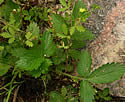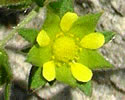Potentilla rivalis (Brook Cinquefoil)
| Also known as: | |
|---|---|
| Genus: | Potentilla |
| Family: | Rosaceae (Rose) |
| Life cycle: | annual, biennial |
| Origin: | native |
| Habitat: | sun; damp soil; lake shores, stream banks |
| Bloom season: | June - August |
| Plant height: | 8 to 12 inches |
| Wetland Indicator Status: | GP: FACW MW: FACW NCNE: FACW |
| MN county distribution (click map to enlarge): |  |
| National distribution (click map to enlarge): |  |
Pick an image for a larger view. See the glossary for icon descriptions.
Detailed Information
Flower: 

![[photo of flowers]](/udata/r9ndp23q/pd/potentilla-rivalis-79802-5-t.jpg) Small, branching, leafy clusters at the branch tips. Flowers are short-stalked, pale yellow, ¼ inch or less across with 5 very small oval-elliptic petals. Alternating between the petals are larger, lance oval shaped sepals that are conspicuously longer than the petals. Behind the sepals and alternating between them are 5 narrower, lance shaped bractlets that are slightly shorter than the sepals but longer than the petal that it sits directly behind. The outer surface of bractlets and sepals are hairy.
Small, branching, leafy clusters at the branch tips. Flowers are short-stalked, pale yellow, ¼ inch or less across with 5 very small oval-elliptic petals. Alternating between the petals are larger, lance oval shaped sepals that are conspicuously longer than the petals. Behind the sepals and alternating between them are 5 narrower, lance shaped bractlets that are slightly shorter than the sepals but longer than the petal that it sits directly behind. The outer surface of bractlets and sepals are hairy.
Leaves and stems: 



![[photo of basal leaves]](/udata/r9ndp23q/pd/potentilla-rivalis-12-13-t.jpg) The early, most basal leaves are long stalked, 2 to 3 inches long, pinnately or palmately compound with 7 leaflets, or 5 leaflets with the end leaflet cleft into 3 lobes. Lower stem leaves are often nearly palmate with 5 leaflets, becoming palmate in 3s, progressively smaller and nearly stalkless in the flower cluster. Leaflets are oblong to oval with coarse, deeply toothed edges; the surfaces are nearly smooth or with soft short hairs.
The early, most basal leaves are long stalked, 2 to 3 inches long, pinnately or palmately compound with 7 leaflets, or 5 leaflets with the end leaflet cleft into 3 lobes. Lower stem leaves are often nearly palmate with 5 leaflets, becoming palmate in 3s, progressively smaller and nearly stalkless in the flower cluster. Leaflets are oblong to oval with coarse, deeply toothed edges; the surfaces are nearly smooth or with soft short hairs.
![[photo of stipules and stem leaves]](/udata/r9ndp23q/pd/potentilla-rivalis-12-14-t.jpg) At the base of the leaf stalk is a pair of lance to egg-shaped leafy appendages (stipules), pointed at the tip, the edges smooth or with a few small teeth. Stems are often tinged red, nearly smooth to softly hairy, weakly erect to ascending and diffusely branched in the upper plant.
At the base of the leaf stalk is a pair of lance to egg-shaped leafy appendages (stipules), pointed at the tip, the edges smooth or with a few small teeth. Stems are often tinged red, nearly smooth to softly hairy, weakly erect to ascending and diffusely branched in the upper plant.
Notes:
Brook Cinquefoil is uncommon in Minnesota with most of the infrequent collections associated with shallow beach lines and low moist areas adjacent to lakes in northwestern counties that are subjected to falling seasonal lake levels. While unlikely to be encountered, there is a common and wide-spread Potentilla species with which it can be confused, especially when many of the lower leaves of both have withered away in late season, leaving just the smaller 3-parted leaves on the upper branches. Like P. rivalis, the more common Rough Cinquefoil (P. norvegica) has petals that are shorter than the surrounding sepals and bractlets. However the flowers of P. rivalis are typically only ¼ inch across with petals strongly oval-elliptic to egg-shaped, where in P. norvegica the flowers are nearly ½ inch across and the petals are larger, rounder and more heart-shaped. Without the flower petals, which often whither away on both by early afternoon, check the stems, where P. rivalis has mostly fine soft, woolly hairs (pubescent) and stipules that are mostly toothless, where P. norvegica has coarse and spreading hairs and mostly sharply toothed stipules.
Native Plant Nurseries, Restoration and Landscaping Services ↓
More photos
Photos courtesy Peter M. Dziuk taken near Garrison, North Dakota, on the exposed receding shorelines of Lake Sakakawea.
Comments
Have you seen this plant in Minnesota, or have any other comments about it?
on: 2014-07-27 16:24:02
I believe I have this plant on my property. Fits the description more than does rough cinquefoil. Present in wetland area. I can get photographs.







 Brook Cinquefoil plant
Brook Cinquefoil plant Brook Cinquefoil with emerging Rough Cinquefoil
Brook Cinquefoil with emerging Rough Cinquefoil more flowers
more flowers